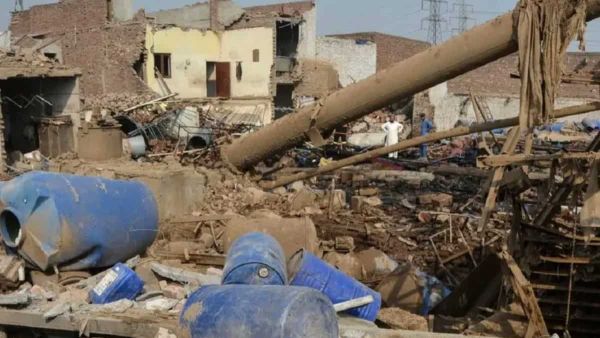India's average temperature rose by nearly 0.9 degrees Celsius in the last decade (2015-2024) with the number of warm days increasing across most of the country, a new study says, highlighting the urgent need for adaptation strategies.
The hottest day of the year also registered a temperature rise of 1.5-2 degrees Celsius in western and northeast India since the 1950s, the study found.
The research by climate scientists Chirag Dhara (Krea University, India), Aditi Deshpande (Savitribai Phule Pune University), Roxy Mathew Koll (Indian Institute of Tropical Meteorology), Padmini Dalpadado (Institute of Marine Research, Norway) and Mandira Singh Shrestha (International Center for Integrated Mountain Development, Nepal), states that this warming is driving a surge in extreme weather events.
The new peer-reviewed study synthesises the latest observational data and climate model projections to paint a stark picture, the researchers said.
"India's average temperature has risen by nearly 0.9 degrees Celsius in the last decade (2015-2024) compared to the early 20th century (1901-1930), with the hottest day of the year warming by 1.5-2 degrees Celsius in western and northeast India since the 1950s," the paper said.
It was leading to more frequent and intense heat waves, with the number of warm days increasing by 5-10 days per decade.
Region wise, the Hindukush Himalayas observed accelerated warming and glacier melt, while the Indo-Gangetic plains witnessed increase in heat stress and decline in the June-July-August-September (JJAS) rainfall.
Northwest India witnessed an increase in warm days and warm nights, the western India experienced a rise in extreme rainfall and an increase in warm days and warm nights. The western coast saw an increase in severe tropical cyclones and rise in sea levels, while the Arabian Sea also witnessed accelerated warming, the study said.
The northeast India recorded decline in JJAS rainfall, increase in warm days and warm nights. The Sundarbans saw an increase in sea level, coupled with increase in heat stress and warm nights. Central India witnessed a rise in extreme rainfall.
The southeast India saw an increase in warm days and warm nights, and an increase in the northeast rainfall.
The research particularly highlights the growing risk of concurrent heatwaves and droughts, which can have a far more devastating impact than either event occurring in isolation. These "compound events" can overwhelm response capacities and lead to cascading impacts on agriculture, water systems, and human health, it pointed out.
The study emphasises that as global temperatures continue to rise, the frequency and intensity of these compound extremes in India are expected to increase.
The tropical Indian Ocean is warming at a rate of 0.12 degrees Celsius per decade, one of the fastest in the world. This is fueling a dramatic increase in marine heatwaves, which are projected to occur for nearly 200 days per year by 2050, from merely 20 days per year in recent decades.
"This poses a grave threat to marine ecosystems, including coral reefs and fisheries, which are vital for the livelihoods of millions," the study said.
The study also observed that the Arabian Sea has become a hotspot for intense tropical cyclones, with the maximum intensity of pre-monsoon cyclones increasing by 40 per cent in recent decades. This, combined with rising sea levels, is heightening the risk of coastal flooding and storm surges.
The study also projects that historical one-in-a-hundred-year extreme sea-level events will become an annual occurrence by mid-century.
A particularly alarming finding of the study is the projected increase in "compound extremes", which refer to the simultaneous or sequential occurrence of multiple climate hazards.
The findings underscore the urgent need for India to ramp up its climate adaptation and mitigation efforts. The authors call for the development of robust, region-specific adaptation strategies grounded in the latest climate science. This includes building more resilient infrastructure, multi-hazard Early Warning Systems, and climate-smart agricultural practices for extreme weather events, the report said.
The hottest day of the year also registered a temperature rise of 1.5-2 degrees Celsius in western and northeast India since the 1950s, the study found.
The research by climate scientists Chirag Dhara (Krea University, India), Aditi Deshpande (Savitribai Phule Pune University), Roxy Mathew Koll (Indian Institute of Tropical Meteorology), Padmini Dalpadado (Institute of Marine Research, Norway) and Mandira Singh Shrestha (International Center for Integrated Mountain Development, Nepal), states that this warming is driving a surge in extreme weather events.
The new peer-reviewed study synthesises the latest observational data and climate model projections to paint a stark picture, the researchers said.
"India's average temperature has risen by nearly 0.9 degrees Celsius in the last decade (2015-2024) compared to the early 20th century (1901-1930), with the hottest day of the year warming by 1.5-2 degrees Celsius in western and northeast India since the 1950s," the paper said.
It was leading to more frequent and intense heat waves, with the number of warm days increasing by 5-10 days per decade.
Region wise, the Hindukush Himalayas observed accelerated warming and glacier melt, while the Indo-Gangetic plains witnessed increase in heat stress and decline in the June-July-August-September (JJAS) rainfall.
Northwest India witnessed an increase in warm days and warm nights, the western India experienced a rise in extreme rainfall and an increase in warm days and warm nights. The western coast saw an increase in severe tropical cyclones and rise in sea levels, while the Arabian Sea also witnessed accelerated warming, the study said.
The northeast India recorded decline in JJAS rainfall, increase in warm days and warm nights. The Sundarbans saw an increase in sea level, coupled with increase in heat stress and warm nights. Central India witnessed a rise in extreme rainfall.
The southeast India saw an increase in warm days and warm nights, and an increase in the northeast rainfall.
The research particularly highlights the growing risk of concurrent heatwaves and droughts, which can have a far more devastating impact than either event occurring in isolation. These "compound events" can overwhelm response capacities and lead to cascading impacts on agriculture, water systems, and human health, it pointed out.
The study emphasises that as global temperatures continue to rise, the frequency and intensity of these compound extremes in India are expected to increase.
The tropical Indian Ocean is warming at a rate of 0.12 degrees Celsius per decade, one of the fastest in the world. This is fueling a dramatic increase in marine heatwaves, which are projected to occur for nearly 200 days per year by 2050, from merely 20 days per year in recent decades.
"This poses a grave threat to marine ecosystems, including coral reefs and fisheries, which are vital for the livelihoods of millions," the study said.
The study also observed that the Arabian Sea has become a hotspot for intense tropical cyclones, with the maximum intensity of pre-monsoon cyclones increasing by 40 per cent in recent decades. This, combined with rising sea levels, is heightening the risk of coastal flooding and storm surges.
The study also projects that historical one-in-a-hundred-year extreme sea-level events will become an annual occurrence by mid-century.
A particularly alarming finding of the study is the projected increase in "compound extremes", which refer to the simultaneous or sequential occurrence of multiple climate hazards.
The findings underscore the urgent need for India to ramp up its climate adaptation and mitigation efforts. The authors call for the development of robust, region-specific adaptation strategies grounded in the latest climate science. This includes building more resilient infrastructure, multi-hazard Early Warning Systems, and climate-smart agricultural practices for extreme weather events, the report said.








